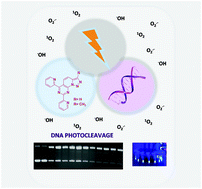Triazolopyridopyrimidines: an emerging family of effective DNA photocleavers. DNA binding. Antileishmanial activity†
Abstract
Triazolopyridopyrimidines 3-phenyl-6,8-di(2-pyridyl)-[1,2,3]triazolo[5′,1′:6,1]pyrido[2,3-d]pyrimidine (1a), 6,8-di(pyridin-2-yl)-[1,2,3]triazolo[1′,5′:1,6]pyrido[2,3-d]pyrimidine (1b) and 3-methyl-6,8-di(2-pyridyl)-[1,2,3]triazolo[5′,1′:6,1]pyrido[2,3-d]pyrimidine (1c) were prepared and their electrochemical and luminescence properties were studied in depth. The DNA binding ability of this series of compounds has been investigated by means of UV-vis absorption and fluorescence titrations, steady-state emission quenching with ferrocyanide as well as viscosity measurements. Results have shown that triazolopyridopyrimidine 1a interacts strongly at DNA grooves. This compound also displays preferential binding to GC-rich sequences and the ability to photooxidize guanine. Moreover, these studies have revealed the key role of the phenyl substituent at the triazole ring in the binding affinity of 1a–c. Compounds 1b and 1c did not show appreciable propensity for DNA binding, however these triazolopyridopyrimidines demonstrated to present photoinduced DNA cleavage activity, 1b being more active than 1c. DNA photocleavage mediated by these compounds takes place mainly through single strand scission events and, in a minor extent, through double strand cuts. Mechanistic investigations using radical scavengers showed that both 1b and 1c generate reactive oxygen species (singlet oxygen, superoxide and hydroxyl radicals) upon irradiation. Both type I and type II mechanisms are involved in the photocleavage process. Furthermore, compounds 1a–c were tested for their antiprotozoal activity against four different Leishmania spp. (L. infantum, L. braziliensis, L. guyanensis and L. amazonensis). Triazolopyridopyrimidines 1a and 1c resulted to be more active and selective than the reference drug (miltefosine) in vitro against L. infantum amastigotes. Compound 1a exhibited high leishmanicidal activity against L. infantum spleen forms in the in vivo test.


 Please wait while we load your content...
Please wait while we load your content...